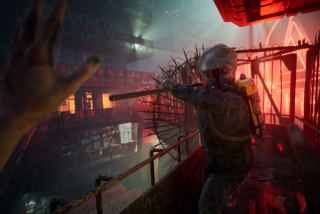Latest Indiana Jones an Adventure in Tedium
- Share via
Can it be that the guy whose very name defines action and adventure in the minds of a generation has been supplanted by a British PhD with a pigtail? After three movies and a variety of digital outings, the whip-wielding Indiana Jones may be showing signs of age. Watching him leap lazily around the screen in his latest adventure makes me long for “Tomb Raider’s” Lara Croft.
The aptly named “Indiana Jones and the Infernal Machine” for the PC is a tiresome trek through canyons, temples and caves crawling with all manner of nasty critters and evil monsters. Sounds fun, I know. But it’s not as fun as it should be.
“Infernal Machine” takes place in 1947. The war is over, and Indy has returned to the desert to dig up bones or whatever it is he looks for. Meanwhile, the Soviet Union is exploring the ruins of Babylon. Turns out the Tower of Babel may not have been man’s attempt to reach the heavens, but rather the housing for a machine that can “reach across the dimensions of space and time.”
Cool.
Really, though, the game focuses mainly on Indy chasing the Commies around the world in search of the parts to rebuild the machine. Each piece is protected by a supernatural guardian, which Indy must beat if he is to save the world from the Reds. Beating “Infernal Machine” is hard--in no small part because Indy seems so easy to kill. Slide down a slope? Indy dies. Step on a snake? Indy dies. Stay underwater too long? Indy dies.
That may be realistic, but who buys video games for realism? Indy was a lot tougher in the movies. To be fair, many of the situations Indy finds himself in are at least interesting and true to the spirit of the films. Indy hates snakes. So it’s only natural that one of the meanest monsters in the game is a super-sized slitherer from the beyond.
Graphically, the game looks nice, which is no surprise, since “Infernal Machine” requires graphics hardware to run. But Indy moves smoothly, and the details that make the game more pleasant than some are nicely done. The backgrounds are beautiful.
And although control is better than in the notoriously buggy “Tomb Raider” series, it’s nothing to brag about. Indy just sort of lazes along and never seems to move with much speed or vigor. Part of that is the inherent difficulty in making a third-person game three-dimensional. At some point or another, the camera is going to be in just the wrong place, making it difficult to judge the distance between ledges or the angle of an enemy’s attack.
Ultimately, though, “Infernal Machine” fails to excite because there’s not much there to get excited about. In film, Indiana Jones rekindled the rip-roaring action genre. And while Indy staked out some territory in side-scrolling adventures on 16-bit consoles, “Tomb Raider’s” Lara Croft basically swiped the franchise in the three-dimensional third-person adventures.
Whereas someone might have been tempted a few years ago to brand Lara Croft a modern Indiana Jones with a bigger cup size, today it feels as if Indiana Jones is just another Lara Croft imitator with a cool hat and five o’clock shadow. That’s a shame.
“Indiana Jones and the Infernal Machine” requires a Pentium 200 with 32 megabytes of RAM and a 3-D accelerator card with at least 4mb of RAM.
‘Medal of Honor’
If Steven Spielberg had made a video game based on “Saving Private Ryan,” many of the same people who praised that film so lavishly would condemn him for glorifying a terrible conflict. Yet “Medal of Honor” for Sony PlayStation seems in many respects to be an extension of “Private Ryan.”
With a few notable exceptions, of course. “Medal of Honor” has no moral. It does not present war as a particularly horrific experience. In fact, players are presented at the end of each level with a score sheet that breaks down where enemy soldiers and officers were shot: head, torso, right arm, left arm, groin.
This is standard stuff for video games. But it provoked a reaction in me that is difficult to explain. The game was produced by DreamWorks Interactive, the games division of the studio Spielberg started with David Geffen and Jeffrey Katzenberg--the same studio that produced “Private Ryan.” And the game is based on real conflicts: Players assume the role of a young lieutenant who infiltrates the German lines in the days after the Normandy invasion.
The film dwelled on the gray areas of battle--the sense of duty, the feeling of cowardice, the remnants of humanity. The game traffics in no such complexities. If someone speaks German, shoot him. Shooting him in the head saves ammunition. Some levels require stealth and secrecy, but this is basically a shooter.
As a game, “Medal of Honor” is engaging. Players sneak through dark terrain, trying to avoid Nazi troops as they search for downed planes and pursue other top-secret objectives. Success depends on true strategic thinking as well as a good aim. It’s a tense experience--and throughout the game I could not help thinking of “Private Ryan.”
It is an odd juxtaposition, and one I never got entirely comfortable with.
‘Rocket: Robot on Wheels’
“Rocket: Robot on Wheels” for Nintendo 64 presents no such moral problems. It is the breezy tale of a robot--yes, on wheels--that accidentally loses a maniacal raccoon and a sleepy walrus at a futuristic theme park. So Rocket--that’s the robot’s name--must find JoJo the raccoon and Whoopie the walrus before the park opens to the public.
Simple as “Rocket” is, it’s a blast to play. The various areas of the theme park are bright and colorful and full of fantastic structures. Rocket can control all sorts of extra vehicles--from magic carpets to dune buggies--as he tracks the errant animals.
At times, it seems as if “Rocket” has no rhyme or reason. That must be what makes it so fun.
*
Aaron Curtiss, formerly a Times editorial writer, is participating in a management training program, in which he currently is serving as assistant to the senior vice president of advertising. He has no financial dealings with the companies he covers. To comment on a column or to suggest games for review, send e-mail to aaron.curtiss@latimes.com.
(BEGIN TEXT OF INFOBOX / INFOGRAPHIC)
Essentials
Indiana Jones and the Infernal Machine
* Platform: PC
* Publisher: LucasArts
* ESRB* rating: Teen
* Price: $39.99
* Bottom line: Lara Croft’s understudy
Medal of Honor
* Platform: Sony PlayStation
* Publisher: DreamWorks Interactive
* ESRB* rating: Teen
* Price: $39.99
* Bottom line: If “Saving Private Ryan” were a game
Rocket: Robot on Wheels
* Platform: Nintendo 64
* Publisher: Ubi Soft
* ESRB* rating: Everyone
* Price: $59.99
* Bottom line: Rolls right along
*
Next Week: The Top 10 gaming items of 1999.
More to Read
The biggest entertainment stories
Get our big stories about Hollywood, film, television, music, arts, culture and more right in your inbox as soon as they publish.
You may occasionally receive promotional content from the Los Angeles Times.










